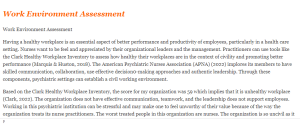Work Environment Assessment
Work Environment Assessment
Having a healthy workplace is an essential aspect of better performance and productivity of employees, particularly in a health care setting. Nurses want to be feel and appreciated by their organizational leaders and the management. Practitioners can use tools like the Clark Healthy Workplace Inventory to assess how healthy their workplaces are in the context of civility and promoting better performance (Marquis & Huston, 2018). The American Psychiatric Nurses Association (APNA) (2022) implores its members to have skilled communication, collaboration, use effective decision0-making approaches and authentic leadership. Through these components, psychiatric settings can establish a civil working environment.
Based on the Clark Healthy Workplace Inventory, the score for my organization was 59 which implies that it is unhealthy workplace (Clark, 2022). The organization does not have effective communication, teamwork, and the leadership does not support employees. Working in this psychiatric institution can be stressful and may make one to feel unworthy of their value because of the way the organization treats its nurse practitioners. The worst treated people in this organization are nurses. The organization is so uncivil as it does not matter if a nurse is assaulted as long as they are not patients. The implication is that the workplace is not civil as nurses are not treated with compassion and recognition that they need. Instead, they are treated worse.
I have experienced these situations where a nurse was insulted by the nurse manager before her colleagues and patients for failing to make appropriate notes about the status of the patient based on the medications that they had used. I felt bad because next time it could be me. Imperatively, I believe that my workplace is uncivil. While it was okay to correct the error, how the nurse manager approached it was the issue. The issue was not addressed well and this contributes to reduced motivation among nurses to provide quality care in the facility.
Work Environment Assessment References
American Psychiatric Nurses Association (APNA) (2022). About APNA.
Clark, C. (2022). Core Competencies of Civility in Nursing & Healthcare. Sigma Theta Tau.
Marquis, B. L., & Huston, C. J. (2018). Organizational planning. Leadership roles and
management functions in nursing: Theory and application (9th ed. (pp. 160-185). Philadelphia, PA: Lippincott, Williams & Wilkins.
Williamson, M. (2018). This is who we are: Promoting professional behaviors and civility in
nursing education. Building Healthy Academic Communities Journal, 2(1), 14-24.
Click here to ORDER an A++ paper from our Verified MASTERS and DOCTORATE WRITERS: Work Environment Assessment
According to the American Association of Critical-Care Nurses (AACN), a healthy work environment is characterized by six standards, such as skilled communication, effective decision making, true collaboration, meaningful recognition, appropriate staffing, and authentic leadership (Halm, 2019). Nurse leaders play a significant role in ensuring that all the six standards are met to promote quality outcomes for both the nursing staff and patients. Several strategies are thus adopted by nurse leaders to promote and sustain a positive work environment. Such strategies include promoting a safe place for staff members to voice their concerns and ideas; making sure that values and expectations are clear; keeping the environments simple; keeping the work area uncluttered and orderly; and recognizing volunteerism.
Recently, the Covid-19 pandemic has led to several issues which compromise the work environment of healthcare personnel, if not

well mitigated (Raso, Fitzpatrick, & Masick, 2020). For example, with appropriate planning, hospitals have been able to acquire adequate resources, such as appropriate staffing and the availability of enough PPEs for staff members, to promote a safe and healthy working environment. However, nurses working in remote settings have raised concerns regarding inadequate staffing, and mandatory overtime, which creates an unhealthy work environment, leading to increased nurse pressure, injury rates, fatigue, and compromised provision of safe care.
The American Nurses Association has outlined seven bills of rights for RNs to promote the art of negotiation in enhancing a safe and healthy work environment (Scruth, Garcia, & Buchner, 2018). Nurses are thus required to freely and acquiescently advocate for themselves and their patients, through communication and collaboration, to promote a healthy work environment. This helps them avoid the feeling of victimization, devalued, and unmotivated, hence promoting service provision.
Work Environment Assessment References
Halm, M. (2019). The influence of appropriate staffing and healthy work environments on patient and nurse outcomes. American Journal of Critical Care, 28(2), 152-156. https://doi.org/10.4037/ajcc2019938
Raso, R., Fitzpatrick, J. J., & Masick, K. (2020). Clinical nurses’ perceptions of authentic nurse leadership and healthy work environment. JONA: The Journal of Nursing Administration, 50(9), 489-494. DOI: 10.1097/NNA.0000000000000921
Scruth, E. A., Garcia, S., & Buchner, L. (2018). Work-life quality, healthy work environments, and nurse retention. Clinical Nurse Specialist, 32(3), 111-113. DOI: 10.1097/NUR.0000000000000376

